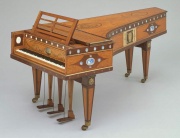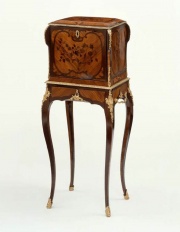Difference between revisions of "Purpleheart"
Jump to navigation
Jump to search
(username removed) |
|||
| (3 intermediate revisions by 3 users not shown) | |||
| Line 1: | Line 1: | ||
| − | [[File:1985.924-SC14552.jpg|thumb|]] | + | [[File:1985.924-SC14552.jpg|thumb|Grand piano<br>MFA# 1985.924]] |
== Description == | == Description == | ||
| − | + | [[File:65.2504-C25964CR-d1.jpg|thumb|Jewelry cabinet<br>MFA# 65.2504]] | |
A purplish hardwood obtained from species in the genus ''Peltogyne'' that are native to tropical regions of Central and South America. Purpleheart or amaranth, wood has a fine, uniform texture and grain that is straight or slightly roey. The durable, shock-resistant wood is sometimes used for carving and for vehicle construction. | A purplish hardwood obtained from species in the genus ''Peltogyne'' that are native to tropical regions of Central and South America. Purpleheart or amaranth, wood has a fine, uniform texture and grain that is straight or slightly roey. The durable, shock-resistant wood is sometimes used for carving and for vehicle construction. | ||
| Line 8: | Line 8: | ||
''Peltogyne''; amaranth (wood); violet wood; amarante (Fr.); amaranto (Esp.) ; pau roxo (Port.) | ''Peltogyne''; amaranth (wood); violet wood; amarante (Fr.); amaranto (Esp.) ; pau roxo (Port.) | ||
| − | + | == Physical and Chemical Properties == | |
| − | == | ||
| − | |||
| − | |||
| − | + | * Tree grows to heights of 50 m and diameter of 1 m. | |
| − | + | * Specific gravity = 0.8-1.0 (air dry) | |
| − | + | * Density = 60-65 ppcf | |
| − | + | * Heartwood is dull purplish brown when cut but with exposure to air turns a deep eggplant purple; with further aging it becomes dark brown | |
| − | + | * Grain is usually straight and texture is medium with a good natural luster | |
| + | * Wood is very resistant to decay and insect attack | ||
== Additional Images == | == Additional Images == | ||
| Line 26: | Line 24: | ||
</gallery> | </gallery> | ||
| + | ==Working Properties== | ||
| + | * If wood is heated with dull tools, or if cutter speeds are too high, purpleheart will exude a gummy resin that can clog tools and complicate the machining process | ||
| + | * Depending on the grain orientation, it can be difficult to plane without tearout. | ||
| − | == | + | ==Resources and Citations== |
| + | * The Wood Database: [https://www.wood-database.com/purpleheart/ Purpleheart] | ||
| − | * | + | * Gordon Hanlon, contributed information, 1998 |
| − | * | + | * Ralph Mayer, ''A Dictionary of Art Terms and Techniques'', Harper and Row Publishers, New York, 1969 (also 1945 printing) |
| − | * | + | * F. H. Titmuss, ''Commercial Timbers of the World'', The Technical Press Ltd., London, 1965 |
[[Category:Materials database]] | [[Category:Materials database]] | ||
Latest revision as of 14:52, 22 October 2022
Description
A purplish hardwood obtained from species in the genus Peltogyne that are native to tropical regions of Central and South America. Purpleheart or amaranth, wood has a fine, uniform texture and grain that is straight or slightly roey. The durable, shock-resistant wood is sometimes used for carving and for vehicle construction.
Synonyms and Related Terms
Peltogyne; amaranth (wood); violet wood; amarante (Fr.); amaranto (Esp.) ; pau roxo (Port.)
Physical and Chemical Properties
- Tree grows to heights of 50 m and diameter of 1 m.
- Specific gravity = 0.8-1.0 (air dry)
- Density = 60-65 ppcf
- Heartwood is dull purplish brown when cut but with exposure to air turns a deep eggplant purple; with further aging it becomes dark brown
- Grain is usually straight and texture is medium with a good natural luster
- Wood is very resistant to decay and insect attack
Additional Images
Working Properties
- If wood is heated with dull tools, or if cutter speeds are too high, purpleheart will exude a gummy resin that can clog tools and complicate the machining process
- Depending on the grain orientation, it can be difficult to plane without tearout.
Resources and Citations
- The Wood Database: Purpleheart
- Gordon Hanlon, contributed information, 1998
- Ralph Mayer, A Dictionary of Art Terms and Techniques, Harper and Row Publishers, New York, 1969 (also 1945 printing)
- F. H. Titmuss, Commercial Timbers of the World, The Technical Press Ltd., London, 1965



